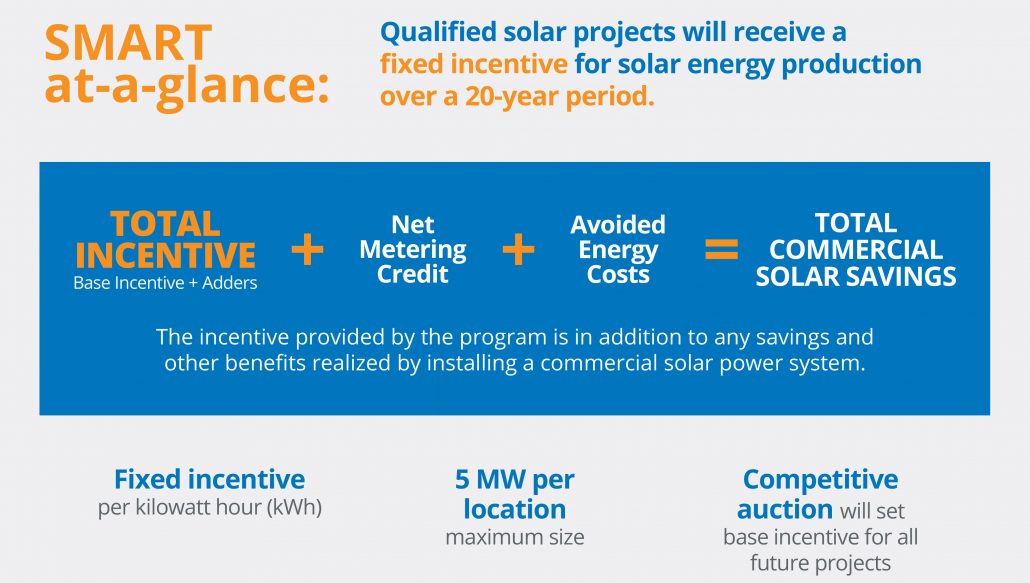The Solar Massachusetts Renewable Target (SMART) incentive, offers fixed incentives for up to 20 years on qualifying solar projects! Massachusetts’ SMART is designed to double the installed capacity of solar in Massachusetts from 1,600 to 3,200 megawatts over the next several years. The program is a long-term sustainable solar incentive program sponsored by Eversource, National Grid and Unitil. As a turn-key installer, SGE will manage the process of getting your solar system installed so you can take full advantage of all the incentives Massachusetts has to offer. Click here for a program overview from the Database of State Incentives for Renewables & Efficiency, or visit the SMART program website.
Financing
Go Solar with No Money Down.
We are incentive experts and work closely with all agencies that offer financial incentives on behalf of our customers. Contact Us for financing options available.
Please visit The Database for Renewable Energy & Efficiency (DSIRE) website for detailed information on Massachusetts incentives. DSIRE is a comprehensive source of information on state, local, utility, and federal incentives that promote renewable energy and energy efficiency. You can also contact us to discuss any incentives or questions you may have.
Go Solar the SMART Way with SGE
The Solar Massachusetts Renewable Target (SMART) incentive, offers fixed incentives for up to 20 years on qualifying solar projects. The SMART program includes an “adders” feature, providing higher incentives for solar installations with desirable characteristics—such as rooftops and carports that provide efficient use of space, behind-the-meter systems, and energy storage.
Basic Features of New Program are as follows:
• 1,600 MW AC declining block program
• Applies to all electric distribution companies
• Same compensation rates across state
• 10 or 20-year fixed price term depending on project capacity (10-year for small, 20-year for large)
• Compensation structure differentiated between sized-to-load and standalone systems
• Base compensation rates set according to project size
• Adders based on location, and those that provide unique benefits, including community solar, low-income, public, and energy storage projects
• Base compensation rates decline by set percentages in each block following Block 1
• Maximum project size of 5 MW per parcel
|
Massachusetts Electric d/b/a National Grid
|
Nantucket Electric d/b/a National Grid
|
NSTAR d/b/a Eversource Energy
|
WMECO d/b/a Eversource Energy
|
Fitchburg Gas & Electric d/b/a Unitil
|
|
|
MW Solicited
|
45
|
2.0
|
46.0
|
8.0
|
4.0
|
|
MW Received
|
53.3
|
0.0
|
2.0
|
13.0
|
0.0
|
|
MW Selected
|
43.5
|
0.0
|
2.0
|
7.7
|
0.0
|
|
Clearing Price ($/kWh)
|
$0.16933
|
N/A
|
$0.17000
|
$0.14890
|
N/A
|
|
Mean Price ($/kWh)
|
$0.15563
|
N/A
|
$0.17000
|
$0.14288
|
N/A
|
|
Block 1 Base Compensation Rate ($/kWh)
|
$0.15563
|
$0.17000
|
$0.17000
|
$0.14288
|
$0.15563
|
SMART Program FAQs
When did the program start?
The SMART program fully replaced SREC II in November 2018.
When will the program run out?
The SMART was doubled from its original capacity in April 2020. SMART will now fund projects until the capacity of 3,200 MW total is reached. There is no set end date; the program will run until capacity is reached.
Do I have to own the system to be part of the SMART program?
You do not have to be the owner of the system to benefit from this program. Organizations that choose to finance their system with options like solar PPAs or leases can still benefit through expected rate reductions passed on from the actual system owner.
Does SMART replace net metering?
The SMART program is separate from net metering credits, and incentive income will be delivered separately from the system owner’s utility bill.
How long is the reservation period?
Your solar solar project must be completed within a 12 months of being accepted by SMART to remain eligible for funds.
Are there any sunlight/shade requirements?
No, there is no maximum amount of shade or minimum amount of sunlight needed for a solar panel system under SMART. Since customers are paid based on how much solar energy they produce, it will benefit the owner to install panel systems with optimal conditions.
How long does the program last?
Customers will receive SMART payments for 10 years for projects under 25 kW, and for 20 years for projects over 25kW.
Project under 25 kW will receive payments for 10 years, and projects over 25 kW will receive payments for 20 years.
What are adders and subtractors?
Adders and subtractors are applied to the base rate, which is the rate per kilowatt hour that customers are paid for the energy they produce.
Adders increase the base rate and are meant to incentivize certain behaviors or types of panel systems. For example, putting solar panels on a roof, parking lot, or landfill would all increase how much a customer could make through the SMART program. Buying a solar battery along with the panel system would also be considered an adder.
One the other hand, subtractors are meant to disincentivize, and therefore reduce the base rate. Cutting down trees in a forest to build solar panels would be considered a subtractor.


